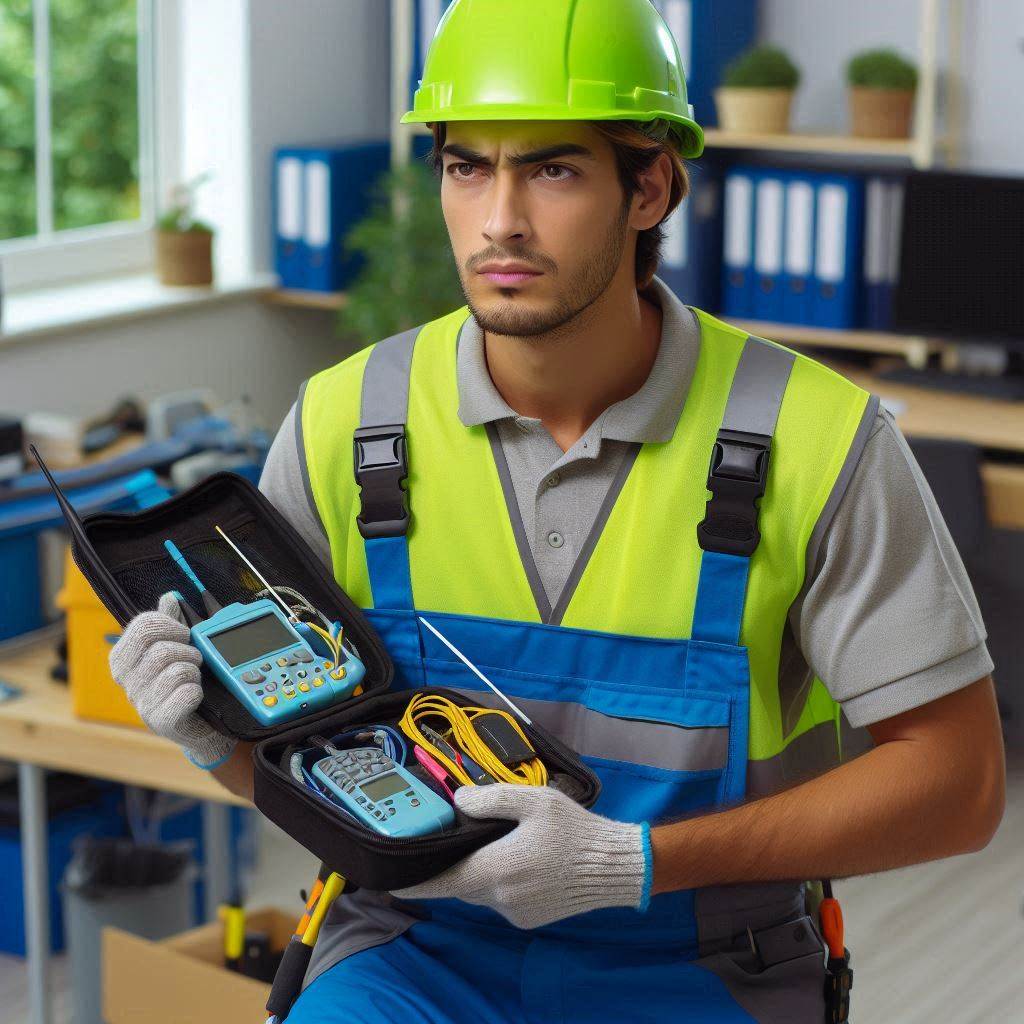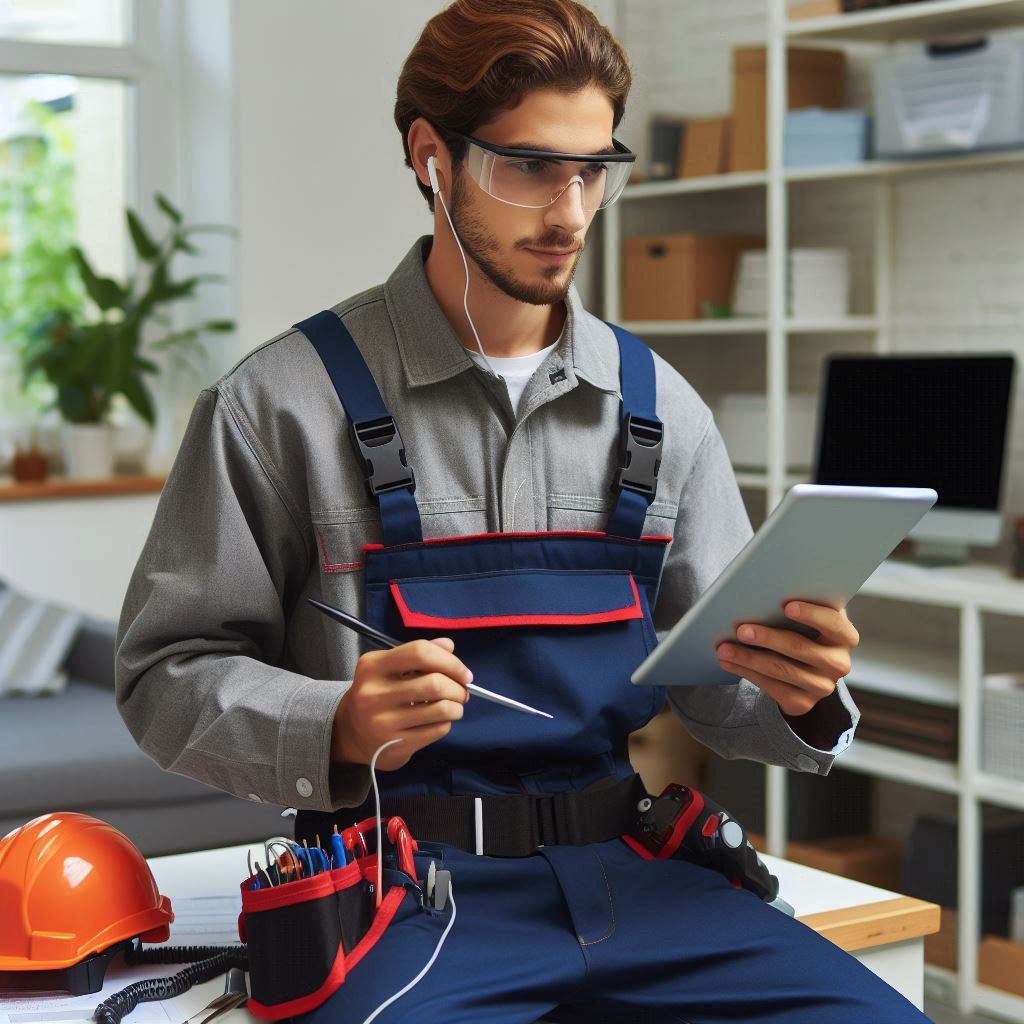Introduction
Field service technicians depend on a diverse range of tools to effectively perform their duties.
These tools are essential for diagnosing, repairing, and maintaining various types of equipment.
Common tools in a technician’s toolkit include multimeters, screwdrivers, pliers, wrenches, and more specialized instruments.
Each of these tools serves a specific purpose, helping technicians address different challenges they encounter on the job.
A multimeter, for instance, is crucial for measuring electrical values and diagnosing electrical issues.
It allows technicians to test voltage, current, and resistance, which are fundamental for troubleshooting electrical problems.
Screwdrivers and pliers are equally important, as they are used for assembling, adjusting, and disassembling components.
Wrenches, both adjustable and fixed, are essential for tightening or loosening bolts and nuts.
The importance of having the right tools cannot be overstated.
Using appropriate tools ensures that tasks are completed efficiently and accurately.
It reduces the risk of errors and potential damage to equipment, which can lead to costly repairs or downtime.
High-quality, reliable tools enable technicians to work more effectively, resulting in faster problem resolution and improved customer satisfaction.
Investing in the right tools not only enhances a technician‘s productivity but also contributes to their professional image.
Well-maintained, high-quality tools reflect a commitment to excellence and attention to detail.
Multi-Tool
Versatility of a Multi-Tool for Various Tasks
A multi-tool is an invaluable asset for field service technicians due to its versatility.
This compact tool integrates multiple functions, enabling technicians to tackle a wide range of tasks efficiently.
Whether working on electrical systems, mechanical repairs, or routine maintenance, a multi-tool provides quick access to essential tools in one convenient package.
Its versatility reduces the need for multiple single-purpose tools, allowing technicians to be more agile and responsive in various situations.
Specific Features Such as Pliers, Screwdrivers, and Knives
The multi-tool’s design incorporates several key features, making it a powerful tool in any technician’s arsenal.
Most multi-tools come equipped with pliers, which are essential for gripping, bending, and cutting wires or small components.
Screwdrivers, another vital component, allow technicians to tighten or loosen screws of various sizes, often with interchangeable heads for different types of screws.
Additionally, a built-in knife is crucial for cutting materials, stripping wires, or even opening packages.
These features make the multi-tool a highly practical option for technicians who need to perform a variety of tasks quickly.
The inclusion of additional tools like wire cutters, saws, and can openers further enhances the multi-tool’s utility, making it suitable for both standard tasks and unexpected challenges.
Technicians can handle minor repairs, adjustments, and installations without needing to carry an extensive array of individual tools.
How a Multi-Tool Can Save Space in a Technician’s Toolkit
One of the most significant advantages of a multi-tool is its ability to save space in a technician‘s toolkit.
By consolidating several tools into one compact device, the multi-tool minimizes the need for carrying a large, cumbersome toolkit.
This space-saving feature is particularly beneficial for field service technicians who are often on the move and need to travel light.
With a multi-tool, technicians can streamline their gear, making it easier to transport and access the tools they need.
In addition to saving space, the multi-tool’s portability ensures that technicians always have essential tools on hand, even in situations where a full toolkit is impractical.
This convenience can lead to faster response times and increased efficiency, as technicians spend less time searching for the right tool and more time focusing on the task at hand.
Overall, the multi-tool’s versatility, combined with its specific features and space-saving design, makes it an indispensable tool for field service technicians.
It allows them to perform a variety of tasks with ease, ensuring they are always prepared to address the challenges of their job.
Investing in a high-quality multi-tool can significantly enhance a technician’s productivity and effectiveness, making it a wise addition to any toolkit.
Digital Multimeter
Importance of a Digital Multimeter for Electrical Troubleshooting
A digital multimeter is essential for field service technicians, particularly in electrical troubleshooting.
It provides precise measurements, helping diagnose and fix issues quickly.
Without a reliable multimeter, technicians risk missing critical problems, leading to potential equipment failures.
The tool’s accuracy and versatility make it indispensable in various service environments, from HVAC systems to industrial machinery.
By using a digital multimeter, technicians can confidently assess electrical components, ensuring that systems operate safely and efficiently.
Types of Measurements a Digital Multimeter Can Perform
Digital multimeters perform a wide range of measurements essential for troubleshooting.
They measure voltage, both AC and DC, allowing technicians to verify the power supply.
They also measure resistance, which is crucial for checking the integrity of electrical circuits.
Additionally, multimeters measure current, enabling technicians to ensure that components draw the correct amount of power.
Advanced models can measure capacitance, frequency, and temperature, offering even more diagnostic capabilities.
The ability to perform these measurements with one tool simplifies the technician’s workflow, saving time and reducing the need for multiple instruments.
Voltage measurements are perhaps the most common use of a digital multimeter.
Technicians use this function to check if power is correctly supplied to a circuit or component.
Resistance measurements help identify issues like broken wires or faulty connections, which can cause intermittent problems or complete system failures.
Current measurements are equally important, as they allow technicians to detect overloaded circuits that could lead to overheating or damage.
Popular Brands and Models Among Field Service Technicians
Several brands and models of digital multimeters are highly regarded among field service technicians for their reliability, durability, and accuracy.
Fluke is one of the most popular brands, known for producing robust multimeters that withstand harsh conditions.
The Fluke 117 is a favored model, offering features like non-contact voltage detection and an easy-to-read display.
It‘s ideal for both professional electricians and field service technicians.
Another trusted brand is Klein Tools, which offers durable and user-friendly multimeters.
The Klein Tools MM400 is a well-regarded model, praised for its solid construction and affordability.
It offers essential functions like voltage, current, and resistance measurements, making it a versatile choice for technicians.
For those seeking advanced features, the Extech EX330 is a popular option.
It includes temperature measurement and a built-in infrared thermometer, making it perfect for HVAC technicians.
Its compact size and multiple functions make it a valuable addition to any technician‘s toolkit.
Basically, a digital multimeter is a crucial tool for field service technicians, especially for electrical troubleshooting.
It performs various essential measurements that ensure systems function safely and efficiently.
Investing in a reliable brand like Fluke, Klein Tools, or Extech guarantees durability and accuracy, making the job easier and more efficient for technicians.
Cordless Drill
Versatility of a Multi-Tool for Various Tasks
A multi-tool is an invaluable asset for field service technicians due to its versatility.
This compact tool integrates multiple functions, enabling technicians to tackle a wide range of tasks efficiently.
Whether working on electrical systems, mechanical repairs, or routine maintenance, a multi-tool provides quick access to essential tools in one convenient package.
Its versatility reduces the need for multiple single-purpose tools, allowing technicians to be more agile and responsive in various situations.
Specific Features Such as Pliers, Screwdrivers, and Knives
The multi-tool’s design incorporates several key features, making it a powerful tool in any technician’s arsenal.
Most multi-tools come equipped with pliers, which are essential for gripping, bending, and cutting wires or small components.
Screwdrivers, another vital component, allow technicians to tighten or loosen screws of various sizes, often with interchangeable heads for different types of screws.
Additionally, a built-in knife is crucial for cutting materials, stripping wires, or even opening packages.
These features make the multi-tool a highly practical option for technicians who need to perform a variety of tasks quickly.
The inclusion of additional tools like wire cutters, saws, and can openers further enhances the multi-tool’s utility, making it suitable for both standard tasks and unexpected challenges.
Technicians can handle minor repairs, adjustments, and installations without needing to carry an extensive array of individual tools.
How a Multi-Tool Can Save Space in a Technician’s Toolkit
One of the most significant advantages of a multi-tool is its ability to save space in a technician‘s toolkit.
By consolidating several tools into one compact device, the multi-tool minimizes the need for carrying a large, cumbersome toolkit.
This space-saving feature is particularly beneficial for field service technicians who are often on the move and need to travel light.
With a multi-tool, technicians can streamline their gear, making it easier to transport and access the tools they need.
In addition to saving space, the multi-tool’s portability ensures that technicians always have essential tools on hand, even in situations where a full toolkit is impractical.
This convenience can lead to faster response times and increased efficiency, as technicians spend less time searching for the right tool and more time focusing on the task at hand.
Overall, the multi-tool’s versatility, combined with its specific features and space-saving design, makes it an indispensable tool for field service technicians.
It allows them to perform a variety of tasks with ease, ensuring they are always prepared to address the challenges of their job.
Investing in a high-quality multi-tool can significantly enhance a technician’s productivity and effectiveness, making it a wise addition to any toolkit.
Read: How to Stay Updated in Environmental Engineering Field
Tape Measure
Usefulness of a Tape Measure for Accurate Measurements
A tape measure is an essential tool for field service technicians.
Accurate measurements ensure proper installation, repair, and maintenance of equipment.
Technicians rely on tape measures to determine the dimensions of spaces, components, and distances.
Without accurate measurements, projects can suffer from delays, rework, and potential safety hazards.
The tape measure‘s simplicity and precision make it a reliable tool in various field service tasks.
Different Types of Tape Measures Available
There are different types of tape measures available, each designed for specific tasks.
Standard tape measures are most common, featuring a retractable metal tape with markings in inches and centimeters.
These are ideal for general-purpose measurements.
For more specialized tasks, there are long tape measures, which can extend up to 100 feet or more.
These are useful for measuring larger areas, such as rooms or outdoor spaces.
Additionally, there are digital tape measures, which provide readings on a digital display.
These offer greater precision and can store measurements for future reference.
Another type is the laser tape measure, which uses laser technology to measure distances accurately.
Laser tape measures are particularly useful in situations where a physical tape may be difficult to use, such as measuring high ceilings or long distances.
This type of tape measure can also calculate area and volume, making it a versatile tool for technicians.
Flexible or cloth tape measures are also available, used mainly for measuring curved or irregular surfaces.
They are commonly used in automotive or appliance repair, where exact measurements are critical for fitting components.
Transform Your Career Today
Unlock a personalized career strategy that drives real results. Get tailored advice and a roadmap designed just for you.
Start NowExamples of Situations Where a Tape Measure Is Essential for Field Service Technicians
Field service technicians encounter many situations where a tape measure is essential.
For instance, during an HVAC installation, a technician needs to measure the space where the unit will be installed.
Accurate measurements ensure that the equipment fits properly and functions efficiently.
In plumbing, technicians use tape measures to determine the length of pipes needed for a project, ensuring that materials are cut to the correct size.
Similarly, electricians rely on tape measures to install wiring at precise distances, ensuring safety and compliance with regulations.
In construction and building maintenance, a tape measure helps technicians assess spaces for repairs, installations, or upgrades.
Whether it’s measuring the height of a fixture, the width of a doorway, or the distance between two points, the tape measure provides the accuracy needed for successful completion of tasks.
Even in more routine jobs, such as furniture assembly or appliance installation, a tape measure is invaluable for ensuring components are aligned and fit as intended.
In review, the tape measure is a fundamental tool for field service technicians, providing accuracy and versatility across various tasks.
Whether using a standard, digital, or laser tape measure, technicians depend on this tool to complete their work with precision and efficiency.
Investing in a quality tape measure is essential for every technician, as it contributes to the success and safety of their projects.
Read: The Future of Environmental Engineering Jobs

Flashlight
Importance of a Reliable Flashlight for Field Service Technicians
Field service technicians often work in challenging environments where proper lighting is essential.
A reliable flashlight becomes indispensable when technicians find themselves in dimly lit areas, such as basements, attics, or inside machinery.
Without adequate lighting, technicians risk making mistakes that can lead to further equipment damage or personal injury.
A dependable flashlight ensures that technicians can see clearly, allowing them to perform tasks with precision and safety.
Different Types of Flashlights and Their Features
There are various types of flashlights available, each designed to meet specific needs.
Traditional incandescent flashlights provide bright light but often have shorter battery life.
They are usually larger and can be more cumbersome to carry around.
In contrast, LED flashlights have become the preferred choice due to their compact size and energy efficiency.
Rechargeable flashlights offer the convenience of being able to power up on the go, while headlamps free up both hands, making them ideal for tasks requiring detailed work in confined spaces.
Some flashlights also come with adjustable brightness levels, which can be useful for conserving battery life or reducing glare when working up close.
Benefits of Using LED Flashlights for Longer Battery Life
LED flashlights are particularly advantageous for field service technicians due to their longer battery life.
LEDs consume less power than traditional bulbs, allowing them to run for extended periods without needing a battery change.
This feature is crucial for technicians who may spend hours working in areas with limited lighting.
The durability of LED bulbs also means they are less likely to break or burn out, reducing the need for frequent replacements.
Additionally, LED flashlights are known for their brighter and more focused light, which enhances visibility in even the darkest conditions.
Moreover, the lightweight design of many LED flashlights makes them easy to carry, whether in a tool belt or pocket.
This portability ensures that technicians always have their light source readily available, reducing downtime caused by poor visibility.
Some advanced LED flashlights also offer features like water resistance and impact resistance, which are beneficial in harsh working environments.
In a nutshell, a reliable flashlight is a crucial tool for field service technicians working in dimly lit areas.
The choice of flashlight can significantly impact a technician‘s ability to perform tasks safely and efficiently.
LED flashlights, with their longer battery life, durability, and superior brightness, offer numerous advantages over traditional flashlights.
By investing in a high-quality LED flashlight, technicians can ensure they are well-prepared for any low-light situation they may encounter, ultimately leading to better job performance and safety.
Read: Environmental Engineering Software and Tools
Adjustable Wrench
Versatility and Usefulness of an Adjustable Wrench
The adjustable wrench is a versatile and indispensable tool for field service technicians.
It excels in tasks that involve tightening or loosening nuts and bolts of various sizes.
Unlike fixed-size wrenches, an adjustable wrench can be adjusted to fit different fastener sizes, making it a practical choice for technicians who deal with diverse equipment and machinery.
The primary feature of an adjustable wrench is its movable jaw, which can be adjusted to fit the size of the fastener.
This adaptability is crucial when working in tight spaces or with equipment that uses multiple fastener sizes.
By simply turning the adjustment screw, technicians can change the jaw width to match the fastener, eliminating the need for multiple wrenches.
This not only saves space in the tool kit but also streamlines the workflow, allowing technicians to switch between tasks more efficiently.
Adjustable wrenches come in various sizes, and selecting the appropriate size is essential for effective operation.
Larger wrenches provide greater leverage and can handle bigger fasteners, while smaller wrenches are better suited for delicate work in confined areas.
This flexibility allows technicians to tackle a wide range of tasks with one tool, making the adjustable wrench a valuable asset in their toolkit.
Choosing the Right Size and Type of Wrench
Choosing the right size and type of adjustable wrench is crucial to achieving optimal performance and avoiding potential issues.
Adjustable wrenches are available in sizes ranging from 4 inches to 24 inches, catering to different needs.
For most general applications, a 6- to 10-inch wrench offers a good balance between reach and torque.
This size is versatile enough to handle a variety of fasteners while remaining compact and easy to maneuver.
When selecting an adjustable wrench, consider the material and construction quality.
Wrenches made from high-quality alloy steel or chrome vanadium steel are more durable and resistant to wear and tear.
These materials ensure that the wrench maintains its strength and performance over time, even with frequent use.
Additionally, a wrench with a comfortable, ergonomic handle reduces hand fatigue and enhances grip, which is particularly important during prolonged use.
Some adjustable wrenches come equipped with a scale or measurement markings on the jaw.
This feature allows technicians to quickly measure the size of the fastener, which can be especially useful when working under time constraints or in challenging conditions.
Choosing a wrench with this feature can enhance efficiency and precision.
Maintenance Tips for Adjustable Wrenches
Proper maintenance is key to ensuring the longevity and effectiveness of an adjustable wrench.
Regular cleaning is essential to remove dirt, grease, and debris that can accumulate during use.
Wipe down the wrench with a clean cloth after each use to keep it in good condition.
For more thorough cleaning, use a mild detergent and water, then dry the wrench completely to prevent rust.
Lubrication is another important aspect of wrench maintenance.
Apply a light machine oil to the moving parts, such as the worm gear and jaw mechanism, to keep them operating smoothly.
Regular lubrication prevents the adjustment screw from becoming stiff or sticking, which can affect performance.
Be sure to wipe off any excess oil to avoid attracting dirt and grime.
Store the adjustable wrench in a dry environment to prevent rust and corrosion.
If rust does develop, use a rust remover or fine steel wool to clean it off.
Regularly inspect the wrench for signs of wear, such as a loose jaw or damaged teeth, and replace it if necessary to ensure safety and functionality.
The adjustable wrench is a versatile tool that provides significant value for field service technicians.
Its ability to fit various fastener sizes makes it a practical choice for a wide range of tasks.
Choosing the right size and type of wrench, along with proper maintenance, ensures that the tool remains effective and reliable.
By investing in a high-quality adjustable wrench and following maintenance tips, technicians can enhance their efficiency and effectiveness on the job.
Read: Tips for Writing Environmental Engineering Reports
See Related Content: Industry Insights: Aerospace Engineering Conferences
Safety Glasses
Importance of Wearing Safety Glasses to Protect Eyes from Debris and Hazards
Wearing safety glasses is crucial for field service technicians.
They protect eyes from debris, chemicals, and other hazards.
During tasks like drilling, cutting, or working with electrical components, technicians face numerous risks.
Safety glasses prevent injuries caused by flying particles or accidental splashes.
Protecting eyes ensures technicians can work safely and maintain clear vision.
Proper eyewear reduces the likelihood of serious injuries, contributing to overall safety on the job.
Different Types of Safety Glasses and Their Features
Several types of safety glasses offer varied protection levels and features.
Basic safety glasses often come with impact-resistant lenses to shield against flying debris.
Anti-fog safety glasses are designed for environments with temperature fluctuations to prevent condensation on lenses.
For those working in bright conditions, sunglasses with UV protection help reduce glare and eye strain.
Additionally, glasses with side shields offer extra protection from peripheral hazards.
Some safety glasses feature adjustable nose pads and temple arms for a customized, comfortable fit.
Choosing the right type ensures maximum protection and comfort.
Tips on Proper Care and Maintenance of Safety Glasses
Proper care and maintenance of safety glasses are essential for ensuring their effectiveness.
Clean lenses regularly using a soft, lint-free cloth to remove dust and smudges.
Use lens cleaning solutions designed for eyewear to avoid damaging coatings.
Store safety glasses in a protective case when not in use to prevent scratches and damage.
Inspect glasses before each use for any signs of wear or damage, such as cracks or loose components.
Replace damaged or scratched lenses promptly to maintain clear vision and protection.
Regular maintenance extends the lifespan of safety glasses and ensures they perform effectively.
In essence, safety glasses are essential for protecting field service technicians from various hazards.
They prevent eye injuries caused by debris and chemicals, ensuring a safer work environment.
Different types of safety glasses offer features suited to specific needs, such as anti-fog or UV protection.
Proper care and maintenance, including regular cleaning and storage, enhance the glasses‘ effectiveness and longevity.
Technicians should always choose the right type of safety glasses and maintain them diligently to ensure optimal protection and performance on the job.
Tool Bag or Toolbox
Importance of Having a Durable and Organized Tool Bag or Toolbox
A durable and organized tool bag or toolbox is crucial for field service technicians.
It ensures that all tools are protected, accessible, and ready for use.
A well-organized storage solution helps prevent loss or damage of tools during transportation.
A sturdy toolbox or bag can withstand the rigors of fieldwork and daily use.
It minimizes downtime and frustration caused by searching for misplaced tools.
Transform Your Career Today
Unlock a personalized career strategy that drives real results. Get tailored advice and a roadmap designed just for you.
Start NowA quality tool bag or toolbox offers compartments and pockets designed to hold various tools securely.
This organization helps technicians find the right tool quickly, saving time and increasing efficiency.
A well-structured tool storage solution also enhances safety by preventing tools from shifting and causing accidents.
Investing in a durable tool bag or toolbox is a wise decision for maintaining productivity and professionalism.
Different Types of Tool Bags and Toolboxes Available
Several types of tool bags and toolboxes are available, each suited for different needs and preferences.
Tool bags are typically made of durable fabric or nylon and feature multiple pockets and compartments.
They are lightweight and offer flexibility in carrying tools. Some tool bags have padded straps for comfort and easy transport.
Toolboxes, on the other hand, are often made from metal or heavy-duty plastic.
They provide a more rigid and secure storage option, with built-in drawers or compartments for organizing tools.
Some toolboxes come with wheels and telescoping handles for easier mobility.
For technicians who need to transport heavy or numerous tools, a rolling toolbox might be the best option.
Tool chests are larger and offer extensive storage capacity.
They are ideal for those who need to organize a wide variety of tools and equipment.
Tool chests often feature multiple drawers and compartments, providing a comprehensive storage solution.
Tips on Organizing Tools Effectively for Quick Access During Field Service Jobs
Effective organization of tools is key to efficiency during field service jobs.
Start by categorizing tools based on their type and function.
Group similar tools together, such as hand tools, electrical testers, and fasteners.
This categorization makes it easier to locate the right tool quickly.
Use removable pouches or small containers within your toolbox or bag to keep small parts and accessories organized.
Labeling these containers can further streamline tool retrieval.
Arrange frequently used tools in easily accessible locations, such as the top of the toolbox or outer pockets of the tool bag.
Reserve deeper compartments or drawers for less frequently used items.
Regularly inspect and maintain your tool bag or toolbox to ensure it remains in good condition.
Check for any damaged or worn-out compartments and replace them as needed.
Keeping your tools clean and well-maintained also contributes to their longevity and performance.
By following these tips, field service technicians can ensure that their tools are well-organized and easily accessible, which enhances their efficiency and effectiveness on the job.
Conclusion
In this blog post, we have discussed several key tools essential for field service technicians, including multimeters, diagnostic scanners, hand tools, and specialized equipment.
These tools play a vital role in diagnosing, repairing, and maintaining various systems and machinery efficiently.
Understanding the functions and applications of each tool is crucial for performing tasks accurately and effectively.
Multimeters are indispensable for measuring electrical values and diagnosing issues in electrical circuits.
Diagnostic scanners provide valuable insights into the health of equipment by reading error codes and system data.
Hand tools like screwdrivers, pliers, and wrenches are fundamental for general repairs and adjustments.
Additionally, specialized tools tailored to specific equipment types can significantly enhance diagnostic accuracy and repair efficiency.
Having the right tools is not just a matter of convenience but a critical factor for success in the field.
Quality tools ensure that technicians can perform their tasks with precision, reducing the likelihood of errors and rework.
Reliable equipment also contributes to overall job safety, minimizing the risk of accidents and injuries.
For example, well-maintained tools reduce the risk of tool failure during critical operations, which can lead to unsafe conditions or damage to equipment.




